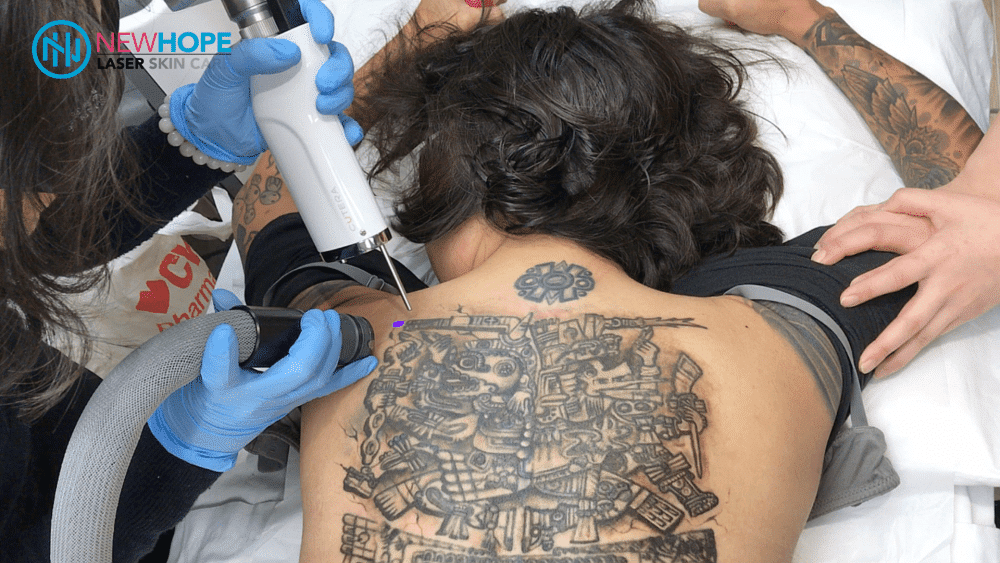Featured image credit: dermaclinicgables.com
Whether it's a case of youthful indiscretion or a change of heart, tattoo regret is a real phenomenon. Thankfully, technology has given us the means to undo these permanent markings - enter the realm of tattoo laser removal.
This groundbreaking method has become the go-to solution for many seeking to erase their ink. Let's delve into the mechanics and expectations of tattoo laser removal.
How Does Tattoo Laser Removal Work

Source: ecmedicalgroup.com
In recent years, lasers have been created expressly to cure and eliminate skin marks. Unwanted tattoos are now typically removed with laser therapy. Laser removal is low risk, non-invasive, and only leaves about 5% of patients with scars.
Although IPL - intense pulsed light therapy does not use lasers, the two procedures are comparable. Birthmarks, hair, discolorations, and other skin abnormalities have all been treated and removed using IPL.
IPL tattoo removal benefits include a quick recovery period (there is no burning and very little sensitivity) and a short treatment interval of 3 to 4 weeks.
The fact that most tattoos can be erased in just 3–4 sessions is the biggest benefit. The cost of IPL is a disadvantage; each pulse might cost $10 or more.
A dermatologist consultation is the first step in the process. Make careful you pick someone with knowledge of tattoo removal.
Based on the size, age, and color(s) of your tattoo, the practitioner can give you a reasonable indication of how many visits you would need and the results you can expect. But keep in mind that the estimate might not be exact.
There are currently about 100 distinct types of tattoo ink available, and some are easier to remove than others.
Most frequently, the pain of a laser pulse is equated to the discomfort of having hot grease spattered on the skin, having hair extracted, or continuously snapping a rubber band.
Some patients choose not to use painkillers, but a dermatologist can prescribe a topical lotion to numb the region or even administer local anaesthetic through injection.
Prior to the surgery, you might also take an over-the-counter analgesic such acetaminophen (found in Tylenol®). Anti-inflammatory medications like ibuprofen (Advil®), which can cause bruising, are not advised.
Each session of the procedure typically lasts 15 to 30 minutes. The tattoo ink absorbs the light energy as laser pulses pass through the skin's epidermis and into the dermis.
The ink, which has been broken up by the laser radiation, is naturally removed from the skin over the next three to six weeks. Each surgery may cause a low-grade inflammation; this has been compared to a minor sunburn, and any discomfort normally goes away within a few days.
The patient is prepared for another appointment with the dermatologist once the skin has recovered and the immune system has completed its task (often after 4–8 weeks).
Compared to an amateur tattoo, a professionally done tattoo may be simpler to erase, or it may be more challenging. Because all of the ink is applied evenly at the same level of the dermis by a skilled tattoo artist, removal is easier to predict.
However, the more recent inks used in tattoo parlors could also be brighter and harder to clean up. Lasers respond best to and may be used to easily remove ink that is black, blue, or red.
The most resilient tattoos are those that use green and yellow ink. Since the inks might fade over time, older tattoos might be simpler to remove than new ones.
Depending on the size, age, and color of the tattoo, the cost and overall time required will vary. Depending on your doctor, each laser removal session might cost anywhere between $200 and $1500.
As a cosmetic operation, tattoo removal is typically not covered by insurance providers. While some tattoos can be removed in just 6 or 8 sessions, others might need 16 or 18 sessions spread out over two years or more.
As you can see, removing a tattoo can be expensive both financially and in terms of time, but it may be worthwhile.
Side Effects Of Laser Tattoo Removal

Source: newhopelaserskincare.com
Because laser treatment targets the pigment in the tattoo specifically, it is frequently safer than many other tattoo removal techniques like excision, dermabrasion, or salabrasion.
There are also hardly any negative effects. However, when making your choice, take into account the following:
- An infection could develop where you removed your tattoo. And there's a small chance that you'll develop a scar that won't go away.
- Your tattoo probably won't be totally removed. Many times, some colors can be eliminated more successfully than others. For instance, tattoos in the colors blue and black respond well to laser therapy.
- Hypopigmentation, in which the treated skin is lighter than the skin around it, is a potential outcome.
- In fact, after treatment, cosmetic tattoos like lip liner, eyeliner, and eyebrows may get darker. They do have a tendency to get older.
Looking to get that regrettable tattoo removed? Check out our list of related posts below for more information about the best tattoo removal techniques.
- Kristen Bell Tattoos - July 15, 2024
- Risks of Tattooing - July 3, 2024
- Early Tattooing Methods - June 22, 2024

